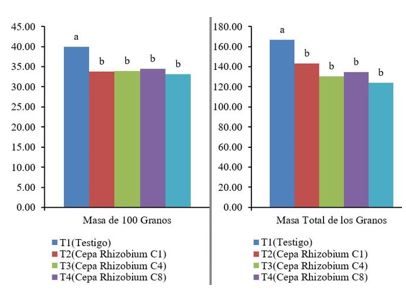Effect of rhizobia on growth and yield of maize (Zea mays L.) cultivar P-79-28
Main Article Content
Abstract
Maize is one of the most important cereals in the world and a strategic crop for food sovereignty and security. The use of bioproducts based on rhizobia in this crop, represents an alternative to decrease chemicals application in their development. The present research was carried out on the "El Mulato" farm, CCS "Orlando Cuellar Peñalver", San José de las Lajas municipality. Developed from December 2018 to April 2019, four strains of Rhizobium sp. were inoculated, with the objective of determining their effect on the growth and yield characters in the P-79-28 maize variety. It was obtained that the different evaluated stains showed positive effects on yield characters. The treatment that obtained the best results in terms of growth characteristics was the one that was inoculated with the C1 strain of Rhizobium sp.
Article Details

This work is licensed under a Creative Commons Attribution-NonCommercial 4.0 International License.
Those authors who have publications with this journal accept the following terms of the License Attribution-NonCommercial 4.0 International (CC BY-NC 4.0):
You are free to:
- Share — copy and redistribute the material in any medium or format
- Adapt — remix, transform, and build upon the material
The licensor cannot revoke these freedoms as long as you follow the license terms.
Under the following terms:
- Attribution — You must give appropriate credit, provide a link to the license, and indicate if changes were made. You may do so in any reasonable manner, but not in any way that suggests the licensor endorses you or your use.
- NonCommercial — You may not use the material for commercial purposes.
- No additional restrictions — You may not apply legal terms or technological measures that legally restrict others from doing anything the license permits.
The journal is not responsible for the opinions and concepts expressed in the works, they are the sole responsibility of the authors. The Editor, with the assistance of the Editorial Committee, reserves the right to suggest or request advisable or necessary modifications. They are accepted to publish original scientific papers, research results of interest that have not been published or sent to another journal for the same purpose.
The mention of trademarks of equipment, instruments or specific materials is for identification purposes, and there is no promotional commitment in relation to them, neither by the authors nor by the publisher.
References
González-Cortés N, Silos-Espino H, Estrada Cabral JC, Chávez-Muñoz JA, Tejero Jiménez L. Características y propiedades del maíz (Zea mays L.) criollo cultivado en Aguascalientes, México. Revista mexicana de ciencias agrícolas. 2016;7(3):669-80.
Produccion Agricola Mundial.com. Producción Mundial de Maíz 2020/2021 [Internet]. 2021 [cited 01/03/2021]. Available from: http://www.produccionagricolamundia l.com/cultivos/maiz.aspx
Rodríguez JHV, Landin WEC, Carreño D de los ÁC, Galarza FAE, Herrera GMI, Cárdenas A del RB, et al. Efecto de 3 formas de fertilización en cultivo de Maíz variedad DAS 3383, La Troncal-Ecuador. Revista Colombiana de Ciencia Animal - RECIA. 2020;12(1):e750e750. doi:10.24188/recia.v12.n1.2020.750
Nehra V, Saharan BS, Choudhary M. Evaluation of Brevibacillus brevis as a potential plant growth promoting rhizobacteria for cotton (Gossypium hirsutum) crop. SpringerPlus. 2016;5(1):1-10. doi:10.1186/s40064-016-2584-8
Calero-Hurtado A, Pérez-Díaz Y, González-Pardo Hurtado Y, Olivera-Viciedo D, Peña-Calzada K, Castro-Lizazo I, et al. Aplicación complementaria de dos bioproductos incrementan la productividad del frijol común. Cultivos Tropicales [Internet]. 2020 [cited 30/03/2021];41(3). Available from: http://scielo.sld.cu/scielo.php?script=sci_ abstract&pid=S0258-59362020000300007&lng=es&nrm=i so&tlng=es
Moreno Reséndez A, García Mendoza V, Reyes Carrillo JL, Vásquez Arroyo J, Cano Ríos P. Rizobacterias promotoras del crecimiento vegetal: una alternativa de biofertilización para la agricultura sustentable. Revista Colombiana de Biotecnología. 2018;20(1):68-83. doi:10.15446/rev.colomb.biote.v20n1.73707
Hernández Forte I, García N, Caridad M. Rizobios residentes en la rizosfera de plantas de arroz (Oryza sativa L.) cultivar INCA LP-5. Cultivos Tropicales. 2017;38(1):39-49.
Jiménez H, Infante B, Jiménez P, Speck C. Clasificación de los suelos de Cuba [Internet]. 1.a ed. Instituto Nacional de Ciencia Agrícolas; 2015 [cited 2/03/2021]. Available from: https://isbn.cloud/9789597023777/clasificacion-delos-suelos-de-cuba-2015/
Pérez Reneé. Aislamiento y caracterización de posibles rizobios asociados a la rizosfera de plantas de maíz (Zea mays) L. Efecto en el crecimiento del cultivo. [Facultad de Biología, Universidad de la Habana]: Universidad de La Habana; 2017. 35-38 p. https://www.researchgate.net/ profile/Renee-Perez-Perez
Carballo A, Ramírez M, Coronado H, Andrade A, SánchezS, Valdés M, et al. Guía Técnica para la Descripción Varietal [Internet]. 2014 [cited 01/03/2021]. Available from: https://www.researchgate.net/publication/313793274_Gui a_Tecnica_para_la_Descripcion_Varietal_de_Maiz
Martínez M, Ortiz R, Ríos H. Caracterización y evaluaciónparticipativa de maíz colectado en la localidad de Catalina de Güines, la Habana. Cultivos Tropicales. 2003; 24(4): 69-75.
Blanco EL, Castro Y, Olivo A, Skwierinski R, Barrios FM.Germinación y crecimiento de plántulas de pimentón y lechuga inoculadas con rizobios e identificación molecular de las cepas. Bioagro. 2018;30(3):207-18.
Marquina ME, Ramírez Y, Castro Y. Efecto de bacteriasrizosféricas en la germinación y crecimiento del pimentón Capsicumannuum L. var. Cacique Gigante. Bioagro. 2018;30(1):3-16.
Bécquer CJ, Salas B. Selección de rizobios adaptados aecosistemas ganaderos de Alberta, Canadá, inoculados en maíz (Zea mays, L.). Fase I: invernadero. Pastos y Forrajes. 2008;31(3):229-46.
Mehboob I, Zahir ZA, Arshad M, Tanveer A, Khalid M.Comparative effectiveness of different Rhizobium sp. for improving growth and yield of maize (Zea mays L.). Soil and Environment. 2012;31(1):37-46.
Hafeez FY, Safdar ME, Chaudhry AU, Malik KA. Rhizobialinoculation improves seedling emergence, nutrient uptake and growth of cotton. Australian Journal of Experimental Agriculture. 2004;44(6):617-22. doi:10.1071/ea03074
Prévost D, Saddiki S, Antoun H. Growth and mineralnutrition of corn inoculated with effective strains of Bradyrhizobium japonicum. En: Proceedings of the 5th International PGPR Workshop. Villa Carlos Paz, Córdoba, Argentina; 2000.
Yanni YG, Rizk RY, El-Fattah FKA, Squartini A, Corich V,Giacomini A, et al. The beneficial plant growth-promoting association of Rhizobium leguminosarum bv. trifolii with rice roots. FunctionalPlantBiology. 2001;28(9):845-70. doi:10.1071/pp01069
